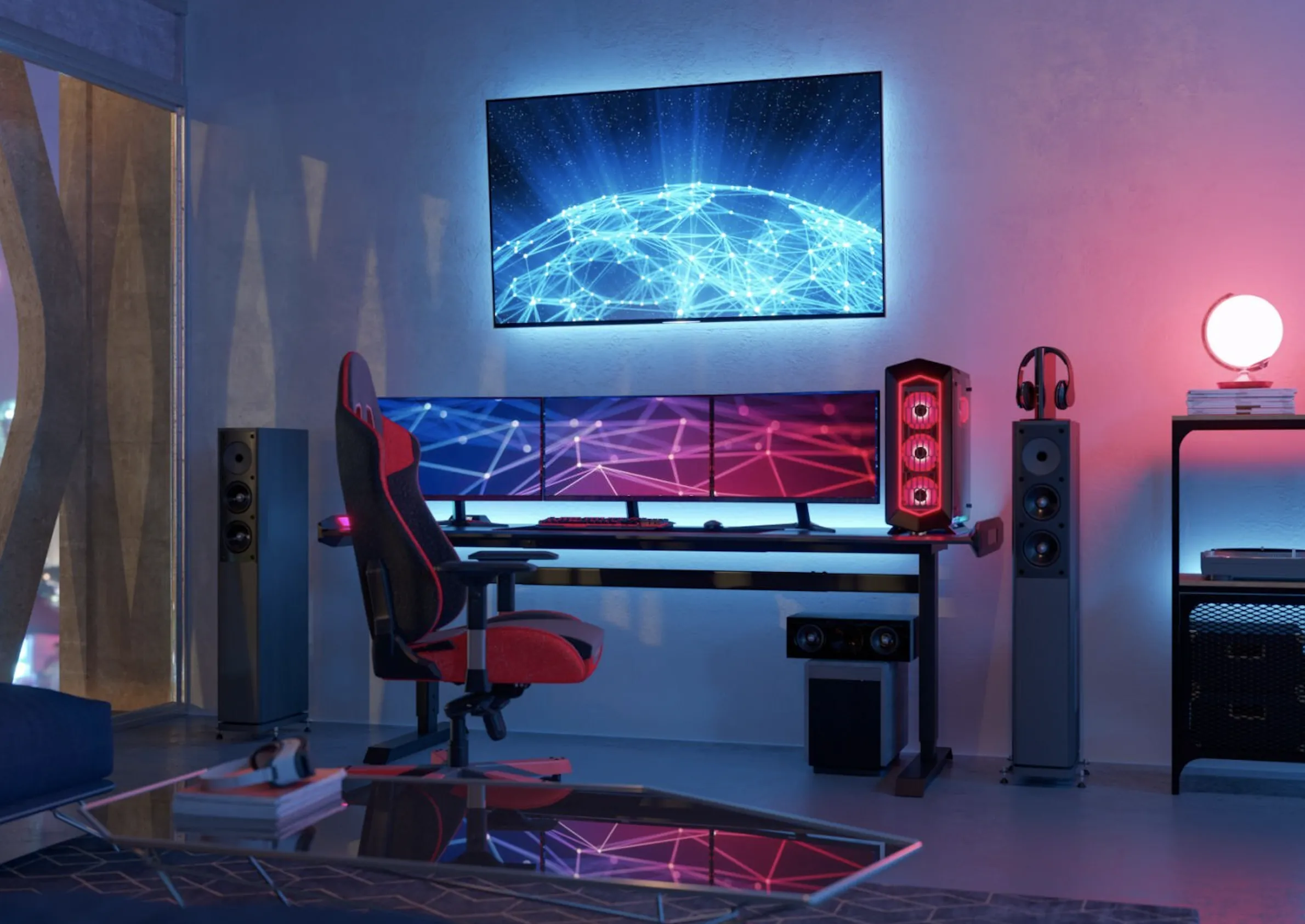If you’re in the market for a new soundbar, you may be wondering what all of those specs mean. What Wattage Soundbar do I Need? Why does frequency response matter? and What is Speaker Sensitivity? Don’t worry, we’re here to help. In this blog post, we’ll explain all of the most important soundbar specs, and tell you how they can impact your audio experience.
Frequency Range
We’ll start with frequency response. This spec tells you how low and high the soundbar can play sounds, measured in hertz (Hz). A higher frequency response means that the soundbar can produce more delicate and nuanced sounds, while a lower frequency response means that the bar can produce richer, fuller sounds.

- Low frequencies are sounds with a pitch of 20 Hz and 200 Hz. They’re mainly produced by the subwoofer, and are responsible for the bass in music.
- Midrange frequencies are sounds with a pitch of between 200 Hz and 2,000 Hz. They’re produced by woofers and midbass speakers, and are responsible for the clarity of voices and instruments in music.
- High frequencies are sounds with a pitch of 2,000 Hz or above. They’re produced by tweeters, and are responsible for the clarity of cymbals and high notes in music.
Each driver is responsible for a certain range of frequencies, so when you’re shopping for a soundbar, be sure to look at the specs to see which ranges each driver covers. This will give you an idea of what type of sounds each driver will produce.
Soundbar Wattage

What Wattage Soundbar do I Need? When it comes to soundbars, many people are unaware of the specs that are associated with them. In particular, wattage is a measurement that is often misunderstood. We will explain what watts means for your soundbar and how it can impact your experience.
Watts refers to the power that is coming from the amplifier. This is important to consider because it will determine how loud and powerful your soundbar can be. Generally, the higher the wattage, the better the sound quality will be. However, it is important to note that not all soundbars are created equal.
Some may have a higher wattage but produce inferior sound quality, while others may have a lower wattage but provide better sound. It is important to do your research and find the best soundbar for your needs.
Additionally, it is important to consider how many watts your soundbar can handle. Most soundbars have a maximum wattage that they can handle without being damaged. If you exceed this wattage, you may damage the soundbar. So, be sure to check the specs before purchasing to make sure that your soundbar can handle the wattage you are looking for.
Ultimately, wattage is an important spec to consider when purchasing a soundbar. It will help you determine how loud and powerful the soundbar can be. Be sure to do your research to find the best soundbar for your needs.
Soundbar Channels

2.1 Channel Speaker Systems
When it comes to home theater sound systems, 2.1 channel speaker systems are a popular option. This type of system includes two left and right speakers, as well as one subwoofer. The addition of the subwoofer provides extra bass and depth, making for a more immersive audio experience when watching movies, TV, or listening to music.
While a 2.1 channel system is not as complex as a 5.1 or 7.1 system, it is still a great option for those looking for a basic home theater sound setup. And thanks to the lack of surround speakers, a 2.1 system is also a good choice for those who want a clutter-free entertainment area. So if you’re looking for great sound without all the extra wires, a 2.1 channel speaker system may be the perfect option for you.
3.1 Channel Speaker Systems
A 3.1 channel speaker system is a great way to get cinematic sound in your home without having to break the bank. This setup includes three main speakers and a subwoofer, and is perfect for those who want enhanced dialogue and stereo sound without any surround sound speakers.
So, if you’re looking to improve your movie-watching experience without spending a fortune, a 3.1 channel speaker system is the way to go.
5.1 Surround Sound System
A 5.1 surround sound system is a six-channel audio setup that delivers an immersive audio experience. It relies on five main speakers and a subwoofer to create an immersive audio experience. The three front speakers are located in the left, center, and right of the room, while the two surround sound speakers are in the back – one on the left and one on the right.
A 5.1 surround sound systems are popular because they deliver an immersive audio experience that is perfect for home theaters. They are used in everything from DVD playback to movie theaters, so you know they are capable of providing an excellent audio experience. Plus, they come in a variety of configurations to fit your needs, so you can create the perfect home theater for your space.
Speaker Sensitivity

What is Speaker Sensitivity (dB or Decibels)? Speaker sensitivity is the measure of how efficiently a speaker converts power (in watts) to volume (in decibels).
Speaker sensitivity is measured by putting a microphone or SPL meter one meter away from the front of the speaker and measuring what volume that delivers with different amounts of power (wattage). Higher sensitivities means that the speaker will play louder with less power.
Anything below 84 dB is considered a poor sensitivity, while 92 dB or higher is very good and should be sought after. In other words, if you are looking for a speaker that doesn’t require a lot of power to be loud, you should look for one with high sensitivity. Conversely, if you are looking for a speaker that can get really loud, you will need to find one with a low sensitivity.
Sensitivity is important to consider when purchasing a speaker because it will help you determine how loudly the speaker can play and how much power you need to supply it. Keep in mind that, as sensitivity goes up, so does price. So, if you are looking for a cheaper speaker, opt for a model with a lower sensitivity rating.
How To Choose The Right Soundbar For Your Needs

The 9 features to consider when buying a soundbar are:
Soundbar Size
When considering the size of a soundbar, it is important to think about the size of your television. If you have a small television, you will need a small soundbar. If you have a large television, you will need a larger soundbar.
Soundbar Style
There are many different styles of soundbars on the market. You can find soundbars that are designed to sit under your television, soundbars that are designed to be wall-mounted, and soundbars that are designed to be placed on a shelf.
Soundbar Quality
It is important to consider the quality of the sound that a soundbar produces before making a purchase. Some soundbars produce high-quality audio while others produce mediocre audio.
Soundbar Features
There are many features that you should consider when buying a soundbar. Some soundbars come with built-in Bluetooth capabilities, which allow you to wirelessly stream audio from your smartphone or tablet. Other soundbars come with built-in surround sound capabilities, which allow you to create a more immersive listening experience.
Soundbar Price
The price of a soundbar can vary greatly depending on the features that it offers. It is important to consider the price of a soundbar before making a purchase.
Soundbar Compatibility
Not all soundbars are compatible with all televisions. It is important to make sure that the soundbar you are considering purchasing is compatible with your television.
Soundbar Weight
Some soundbars are very lightweight and easy to move around, while others are quite heavy and difficult to move. It is important to consider the weight of a soundbar before making a purchase.
Soundbar Size
Some soundbars are quite large and take up a lot of space, while others are small and compact. It is important to consider the size of a soundbar before making a purchase.
Soundbar Warranty
Most soundbars come with a standard warranty that covers any defects in the product. It is important to consider the warranty of a soundbar before making a purchase.
Conclusion
Soundbars have become popular in recent years as a way to enjoy home theater audio without the need for multiple speakers and receivers. However, they are often confusing because there are so many specs on them that it’s hard to know what you should be looking at when shopping. In this article we’ve explained everything from speaker size to wireless connectivity, so that you can make an informed purchase and enjoy your new soundbar to the fullest.
Hopefully this article has helped clear up any confusion about soundbar specs and what they mean for you. Now that you know what to look for, we encourage you to shop around and find the best one for your needs and budget. Thanks for reading!






